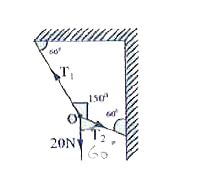(A): An object may have varying speed without having varying velocity
(R) : If the velocity is zero at an instant, the acceleration also zero at that instant.Solution in Telugu
Both (A) and (R) are true and (R) is the correct explanation of (A)
Both (A) and (R) are true and (R) is not the correct explanation of (A)
(A) is true but (R) is false
Both (A) and (R) are fals
The correct Answer is:D
Step by step video, text & image solution for (A): An object may have varying speed without having varying velocity (R) : If the velocity is zero at an instant, the acceleration also zero at that instant. by Physics experts to help you in doubts & scoring excellent marks in Class 12 exams.
Topper's Solved these Questions
- BOOK - AAKASH SERIESCHAPTER - MOTION IN A PLANEEXERCISE - EXERCISE-2 (Addition, Subtraction and Resolution)29videos
MOTION IN A PLANE
- BOOK - AAKASH SERIESCHAPTER - MOTION IN A PLANEEXERCISE - EXERCISE-2 (Lami.s theorem :)8videos
MOTION IN A PLANE
- BOOK - AAKASH SERIESCHAPTER - MOTION IN A PLANEEXERCISE - EXERCISE-IB (Projectile motion)15videos
MOTION IN A PLANE
- BOOK - AAKASH SERIESCHAPTER - MAGNETISMEXERCISE - PROBLEMS (LEVEL-II)13videos
MAGNETISM
- BOOK - AAKASH SERIESCHAPTER - MOTION IN A PLANEEXERCISE - QUESTION FOR DESCRIPTIVE ANSWER7videos
MOTION IN A PLANE
Similar Questions
A person runs along a circular path of radius 5 m. If he completes half of the circle find the magnitude of the displacement vector, How far the person ran ?
04:58View SolutionIf 'O' is at equilibrium then the values of the tension T1andT2 are x, y, if 20 N is vertically down. Then x, y are
 02:19View Solution
02:19View Solution(A): The horizontal displacement of a projectile varies linearly with time.
(R) : Projectile motion is uniform motion along horizontal direction.02:01View SolutionThe force between the two poles is reduced to 'x' newtons when their separation is increased n times. It is increased by 'y' newtons when their separation is made 1/nth of their original value. What is the relation between x and y?
08:13View SolutionA particle is projected over a triangle from one end of a horizontal base and garzing the vertex falls on the other end of the base . If α and β the base angles and θ the angle of projection then show that tanθ=tanα+tanβ.
02:45View SolutionAn object may have (a). Varying speed without having varying velocity (b). Varying velocity without having verying speed (c). Non zero acceleration without having varying velocity (d). Non zero acceleration without having varying speed.
03:14View SolutionAssertion : An object may have varying speed without having varying velocity.
Reason : If the velocity is zero at an instant, the acceleration may not be zero at that instant.View SolutionAssertion : A particle may be momentarily at rest and yet have non-zero acceleration.
Reason : The zero velocity of a particle at any instant does not necessarily imply zero acceleration at that instant.03:38View SolutionCan a paticle have (i) zero speed and non - zero velocity ? (ii) constant velocity but a varying speed ? (iii) constant speed but a varying velcoity ?
View SolutionA : When the velocity of an object is zero at an instant, the acceleration need not be zero at that instant. R : In motion under gravity, the velocity of body is zero at the top - most point.
View SolutionAn object may have ( a) varying speed without having varying velocity (b) varying velocity without having varying speed (c) nonzero acceleration without having varying velocity (d) nonzero acceleration without having varying speed.
View SolutionMark the correct statements for a particle go ing on a straight line: (a) If the velocity and acceleration have opposite sign, the object is slowing down. (b) If the position and velocity have opposite sign, the particle is moving towards the origin. (c) If the velocity is zero at an instant, the acceleration should also be zero at that instant. (d) If the velocity is zero for a time interval, the acceleration is zero at any instant within the time interval.
03:03View SolutionAn object may have
a)varying speed without having varying velocity
b)varying velocity without having varying speed
c) nonzero acceleration without having varying velocity
d)nonzero acceleration without having varying speed.01:19View SolutionAn object may have a) varying speed without having varying velocity b) varying velocity without having varying speed c) nonzero acceleration without having varying velocity d) nonzero acceleration without having varying speed.
View SolutionAn object may have a) varying speed without having varying velocity b) varying velocity without having varying speed c) nonzero acceleration without having varying velocity d) nonzero acceleration without having varying speed.
02:08View Solution

